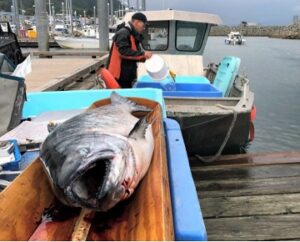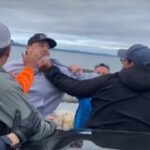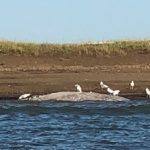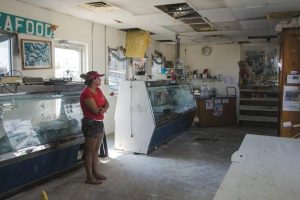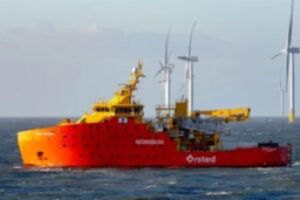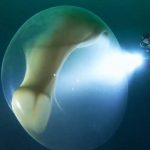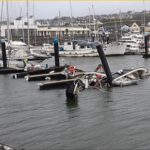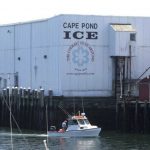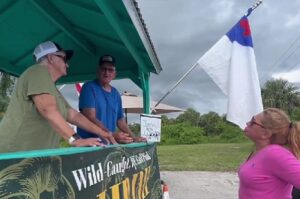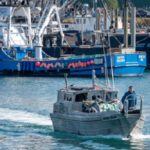Tag Archives: King salmon
Alaska Trollers Association takes a swing at Fish and Game and Alaska sport fishery over shortened season
 Commercial trolling for Southeast king salmon closed for the season in July and will not reopen this month. That marks the second summer in a row their season has ended before they could catch all of their yearly king allocation under an international agreement. Now, the trade group representing them — the Alaska Trollers Association — is outraged. Southeast trollers have around 15,000 kings left in their annual allocation. That’s the number of kings trollers get to catch under an agreement between the United States and Canada known as the Pacific Salmon Treaty. The trollers caught most of their allocation — 83%, or 82,000 fish — during the first and longest opener in July. Typically, the rest of the allocation would be caught in a mid-August opening. But that second opening won’t be happening. more, >>CLICK TO READ<< 16:02
Commercial trolling for Southeast king salmon closed for the season in July and will not reopen this month. That marks the second summer in a row their season has ended before they could catch all of their yearly king allocation under an international agreement. Now, the trade group representing them — the Alaska Trollers Association — is outraged. Southeast trollers have around 15,000 kings left in their annual allocation. That’s the number of kings trollers get to catch under an agreement between the United States and Canada known as the Pacific Salmon Treaty. The trollers caught most of their allocation — 83%, or 82,000 fish — during the first and longest opener in July. Typically, the rest of the allocation would be caught in a mid-August opening. But that second opening won’t be happening. more, >>CLICK TO READ<< 16:02
What does a California ban on salmon mean for the livelihood of fishermen?
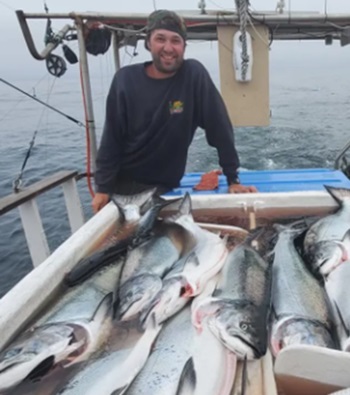 This time of year, Ben Hyman of Wild Local Seafood would like to be out on a boat, fishing for salmon. But for the second year in a row, federal fishery managers have closed all salmon fishing in California. The decision has devastated the state’s fishermen. “The Sacramento River system and the various rivers that stem from it are major producers of king salmon. Some of the largest runs in the world, and especially on the West Coast, have [come] from this river system,” Hyman says. “A lot of the fishing seasons are determined by how many fish make their way up the rivers. “Last year’s closure cost California fishermen approximately $45 million, with some sources saying that is only a fraction of the loss. Hyman says many of his colleagues have left the industry, including third-generation fishermen and those in the business for more than 50 years. more, >>CLICK TO READ<< 07:42
This time of year, Ben Hyman of Wild Local Seafood would like to be out on a boat, fishing for salmon. But for the second year in a row, federal fishery managers have closed all salmon fishing in California. The decision has devastated the state’s fishermen. “The Sacramento River system and the various rivers that stem from it are major producers of king salmon. Some of the largest runs in the world, and especially on the West Coast, have [come] from this river system,” Hyman says. “A lot of the fishing seasons are determined by how many fish make their way up the rivers. “Last year’s closure cost California fishermen approximately $45 million, with some sources saying that is only a fraction of the loss. Hyman says many of his colleagues have left the industry, including third-generation fishermen and those in the business for more than 50 years. more, >>CLICK TO READ<< 07:42
Board of Fisheries passes new Kenai king salmon plan
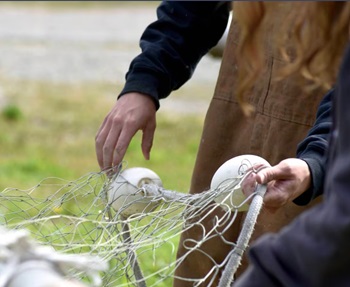 New management policies for Kenai River king salmon mean that sockeye bag limits in the river are up, and commercial setnet fishing is likely to be closed for the foreseeable future. Kenai River late run king salmon are now officially designated a stock of concern, which means a host of changes in the management plan. The Alaska Board of Fisheries finalized the designation at its meeting in Anchorage on March 1, and as part of it, revised the management plan for the fishery to help conserve more of the fish. At its October 2023 meeting, the board reviewed the Stock of Concern designation for the late run, which covers July and August in the Kenai River. At its March meeting, the board decided how to change the management plan to help rebuild the run over time. more, >>click to read<< 14:50
New management policies for Kenai River king salmon mean that sockeye bag limits in the river are up, and commercial setnet fishing is likely to be closed for the foreseeable future. Kenai River late run king salmon are now officially designated a stock of concern, which means a host of changes in the management plan. The Alaska Board of Fisheries finalized the designation at its meeting in Anchorage on March 1, and as part of it, revised the management plan for the fishery to help conserve more of the fish. At its October 2023 meeting, the board reviewed the Stock of Concern designation for the late run, which covers July and August in the Kenai River. At its March meeting, the board decided how to change the management plan to help rebuild the run over time. more, >>click to read<< 14:50
California’s Central Valley Chinook Are Getting Lost on Their Way Home
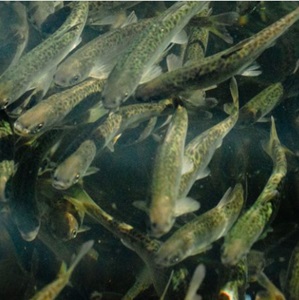 Picture yourself: a chinook salmon in the prime of your life. You dart through the water off California’s central coast, winding through kelp and dodging hungry sea lions. Long, sleek and silver, dappled with dark spots. Eyes wide and vigilant. More than 20 kilograms of pure muscle. You’ve been out at sea for several years now, first voyaging north along the Oregon coastline, then westward into deeper water. As winter approaches and the days grow shorter, you’ve found your way back to California. You’ve felt the seasons turn before, but this year, it means something special. Your kind, the Central Valley chinook—what fishers call the king salmon—are not born at sea. For thousands of years, your ancestors began their lives in the heart of California, where tributaries and streams flow together to form the mighty Sacramento and San Joaquin Rivers. photos, >>click to read<< 08:31
Picture yourself: a chinook salmon in the prime of your life. You dart through the water off California’s central coast, winding through kelp and dodging hungry sea lions. Long, sleek and silver, dappled with dark spots. Eyes wide and vigilant. More than 20 kilograms of pure muscle. You’ve been out at sea for several years now, first voyaging north along the Oregon coastline, then westward into deeper water. As winter approaches and the days grow shorter, you’ve found your way back to California. You’ve felt the seasons turn before, but this year, it means something special. Your kind, the Central Valley chinook—what fishers call the king salmon—are not born at sea. For thousands of years, your ancestors began their lives in the heart of California, where tributaries and streams flow together to form the mighty Sacramento and San Joaquin Rivers. photos, >>click to read<< 08:31
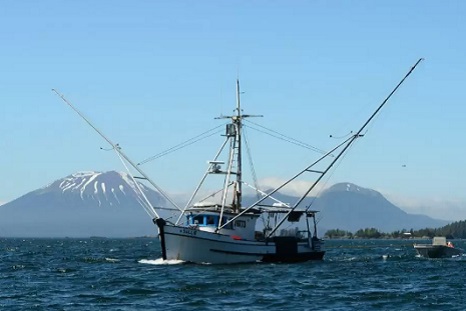
Fish plentiful, but fishermen scarce for Southeast Alaska’s first summer king opening
The numbers are in for the first opening in the summer troll fishery for king salmon in Southeast Alaska. The 12-day season saw more chinook landed than expected, despite fewer boats being on the water. Southeast trollers brought in about 85,000 king salmon from July 1 to July 12, around 8,000 fish over the target for the first opener of the season. At first, it might look like enthusiasm played a role, as it was only on June 21 that the US Ninth Circuit Court of Appeals issued a stay that allowed the fishery to occur at all. But that was not the case. Grant Hagerman manages the troll fishery for the Alaska Department of Fish and Game. He says even fewer trollers participated this summer than in 2022. >click to read< 10:37
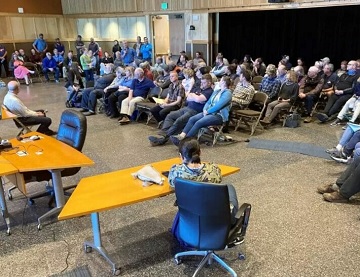
NOAA says revised analysis could allow Southeast king salmon troll fishing, despite ruling
The National Marine Fisheries Service hasn’t ruled out the possibility of opening the summer troll season for king salmon in Southeast Alaska, despite a federal judge’s recent ruling to the contrary. The service’s Alaska regional administrator, Jon Kurland, told a roomful of trollers during a June 7 meeting in Sitka that the agency was working hard to correct the problems identified in the federal lawsuit. The Wild Fish Conservancy in Washington state sued to stop the Southeast Alaska troll season, seeking to protect endangered Southern Resident killer whales’ food sources. >click to read< 12:57
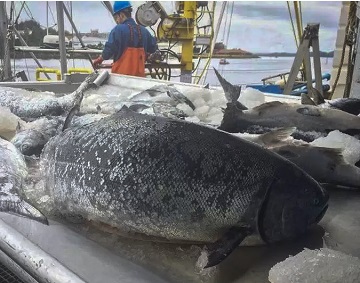
DOJ will appeal court order forcing Southeast Alaska king salmon troll fishery closure
The United States Department of Justice will appeal a federal court order forcing the closure of the commercial king salmon troll fishery in Southeast Alaska. In early May, Washington U.S. District Court Judge Richard Jones upheld an earlier recommendation that the Southeast summer and winter king fisheries were catching too much of the food source of a dwindling population of Puget Sound’s Southern Resident killer whales, in violation of the Endangered Species Act. The defendant intervenors in the case, the Alaska Trollers Association and the State of Alaska, filed motions earlier this month calling for a “partial stay” of the order, pending an appeal to allow the fisheries to proceed. >click to read< 15:58
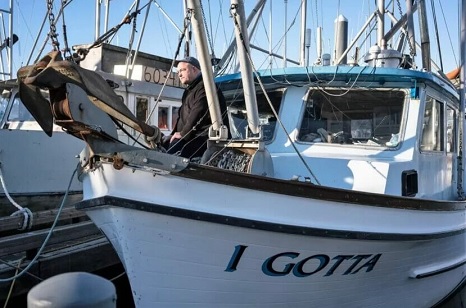
3 Alaska trollers contemplate a summer without chinook
Barring a stay, or a successful appeal, or other eleventh-hour legal action, there will be no troll fishery for king salmon in Southeast Alaska either this summer or winter. The fisheries have been canceled by order of the U.S. District Court of Western Washington on largely procedural grounds. According to the ruling they stem from a violation of the Endangered Species Act, and the failure of the National Marine Fisheries Service to fully address the impact of Alaska’s king salmon trollers on an endangered population of orcas in Puget Sound called Southern Resident killer whales. No other salmon species or commercial gear group or sport fishery anywhere on the entire Pacific Northwest coast is affected by the order, just commercial trolling for king salmon in Southeast Alaska. photos, >click to read/listen< 13:39

Poor outlook for king salmon could shut down California’s sport and commercial seasons
This year’s official “forecast abundance” estimates that just 169,767 adult chinook salmon are waiting off shore to be caught — a substantial decrease from the 396,458 predicted last year and forecasts above 800,000 a decade ago. A nearly 2-month delay in the Dungeness crab season this year meant commercial crabbers missed the Thanksgiving, Christmas and New Year’s holidays and then had a glut of fresh crab available when the market was weak, said veteran fisherman Dick Ogg, vice president of the Bodega Bay Fisherman’s Marketing Association, which represents the local commercial fleet. Though Ogg participates in a variety of fisheries, many locals only do salmon, crab or both. “For the guys that only have salmon as a potential income, it’s going to be devastating,” he said, “and for the guys who have salmon and crab, and who have had a minimal crab season, it’s going to be devastating.” >click to read< 09:05
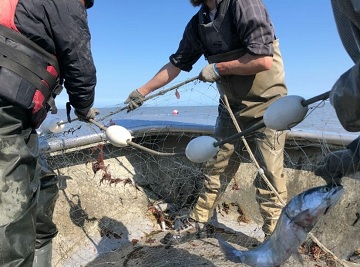
Cook Inlet fishermen sue over set-net closures
Days after they were ordered to take their nets out of the water, Cook Inlet set-netters are suing the state over the fishery’s closure. In a case filed in state court last week, the Cook Inlet Fishermen’s Fund, representing Cook Inlet fishermen, said the state is mismanaging the east-side set-net fishery to the benefit of other user groups. It’s asking the state to immediately reopen the fishery this season to its 440 or so permit-holders, to pay fishermen back for what they lost and to revise the plan that closed it in the first place. Due to restrictions linked to the sport fishery, the east-side set-net fishery in Cook Inlet closes when king salmon abundance on the Kenai River is low. The set-netters were shut down early this year for the fourth year in a row. >click to read< 11:12
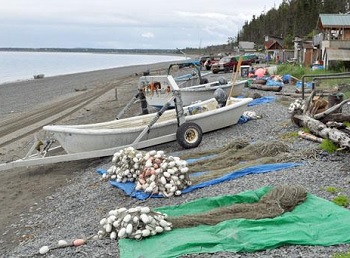
Some setnetters ask state to reopen limited fishery
Commercial setnet fishermen in Cook Inlet had their season cut short last week. When the Alaska Department of Fish and Game closed the Kenai River to sportfishing for king salmon, it closed the east setnet fishery completely. Some of them had only had a handful of openers. There are still plenty of sockeye in the water, which are the main fish the commercial fleet harvests, and setnetters are making some last-ditch plays to try to save some of their season. Ted Crookston, who has been setnetting on the Salamatof beach for nearly six decades, is asking the Board of Fisheries to at least open the setnets in a narrow strip just offshore—out to 600 feet below mean high tide.,, “We’re sitting here on the beach and catastrophically denied access to anything and you’re saying that it’s justified—it’s not,” >click to read< 13:48

One of nature’s miracles: the salmonid species life cycle
This article describes the amazing way these species begin their lives in clear flowing creeks and streams near the coast, anywhere from the northwest to Northern California, travel miles downstream to enter the salty waters of the Pacific Ocean, mature for a number of years while traveling great distances, and then return to their home stream’s birthplace. At the beginning, the following verse from a popular illustrated children’s text titled Salmon Stream sets the scene: The egg of a salmon, born to travel, Hides in the nest of rocky gravel, Far beyond the shady pool,,, >click to read< 20:02
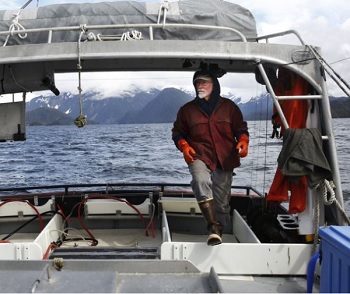
A win for Alaska trollers – Judge denied request for injunction to keep season closed
Magistrate Judge Michelle Peterson, of the US District Court of Western Washington, ruled on Tuesday (6-9-20) that an injunction petition filed by a Washington state environmental organization to protect killer whales circumvents established fisheries law. During oral arguments before her in May (5-28-20), Judge Peterson put hard questions to counsel for the Wild Fish Conservancy about whether the federal court had jurisdiction over the case, when the matter had not been tested before the Alaska Board of Fisheries, or the National Marine Fisheries Service — organizations which have regulated fisheries for the last four decades under the overall umbrella of the Magnuson-Stevens Act. So Judge Peterson’s ruling wasn’t unexpected. Nevertheless Kurt Beardslee, executive director of the Conservancy, says he’s disappointed. >click to read< 08:14

Coho salmon closures on tap for Southeast commercial trollers
Commercial salmon trollers in Southeast can expect a region-wide fishing closure for coho salmon in August. One part of the region is already being shut down because of low coho numbers. But a second king salmon opening is likely to keep the fleet on the water. Trollers have been targeting coho and chum salmon since the end of the five day opening for king salmon at the beginning of July. >click to read< 21:29
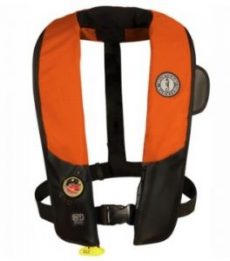
Coast Guard to Conduct Dockside Fishing Vessel Exams for Bristol Bay
The Coast Guard will offer courtesy dockside examinations of commercial fishing vessels in Bristol Bay in anticipation of the 2019 Bristol Bay salmon fishery season. The Coast Guard anticipates sending examiners to the following locations for public outreach and to encourage dockside exam participation: King Salmon: June 6-21, Dillingham: June 10-20, Egegik: June 13-18.,,, In 2018, several fishermen died after falling overboard. None of them were wearing life jackets. The Coast Guard continues to strongly recommend that all fishermen wear life jackets when on the deck of any vessel.
Vessel operators are reminded,,, >click to read<12:25
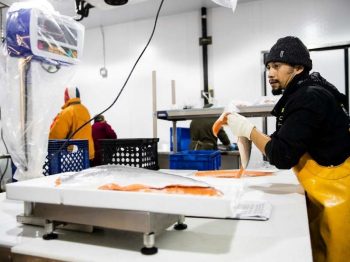
King salmon arrives in stores, commanding royal prices; relief could come soon
King salmon, once as ubiquitous as burgers in backyard Bay Area barbecues, has commanded astonishingly high prices in recent years,,, Since the 2019 season opened on May 1, supply has been very limited, so prices have remained steep, reaching as high as $40 a pound in San Francisco.,,, That should start to change on Thursday, when 200 more miles of coast will open to commercial salmon fishing,… there will likely be more salmon on the market this summer is because some crab boats are planning to go out for salmon fishing, because the Dungeness crab fishery closed several months early as part of a settlement,,, >click to read<21:54

Salmon surge: Habitat improvements paying off on one California river
Near record numbers of chinook salmon are surging up the Mokelumne River, marking the second large spawning year in a row and signaling to fisheries biologists that habitat improvements in recent years are paying off for fish and the people who eat the pinkish delicacies.,,,It is expected to be the best two-year run on the river since records started being kept in 1940, a significant accomplishment given how dismal salmon returns have been over the past three years in virtually every other waterway in California, including the Sacramento River, which last year saw its lowest returns in eight years. >click to read<08:58

One king salmon worth more than a barrel of oil to AK fishermen; Updates for 2018/19
Salmon stakeholders are still crunching the numbers from the 2018 season, which up front has two distinctions: it ranks as one of the most valuable on record to fishermen at nearly $596 million, and at just over 114 million salmon, it’s one of the smallest harvests in 34 years. A breakdown by the McDowell Group shows the sockeye harvest was the second most valuable in 26 years; the chum catch was the third most valuable since 1975. Audio report, >click to read<17:06
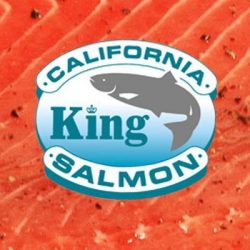
California King Salmon Season Reopens July 26
California’s commercial salmon fishermen are thrilled to again provide some of the world’s best tasting salmon – the California King Salmon! In fact, chefs, foodies and salmon lovers everywhere can again enjoy this iconic summer delicacy right from their local grocery stores, fish markets and restaurants. After a mid-season break, commercial salmon fishermen will begin fishing again on July 26. Prior to the scheduled June 30 closure, the catch was more than double the projection for the May-June season in the Monterey management zone. “There is a larger supply of King Salmon than was anticipated, which is great news for California consumers,” said David Goldenberg, chief executive officer of the California Salmon Council. >click to read<21:05

Kenai River anglers ask for closure of Cook Inlet commercial set netting
The Kenai River Sportfishing Association (KRSA) is calling for the closure of set net fishing on the Cook Inlet until adequate numbers of king and sockeye salmon enter the Kenai River. The organization is asking Gov. Bill Walker to direct the Alaska Department of Fish and Game to take action and help Kenai River salmon numbers rebound.,,, One commercial set netter agrees a closure could benefit harvests for both sides. “As a commercial set netter for almost 50 years, and speaking for myself,” Ken Coleman said, “I believe we commercial fisherman have always been in favor of department closures when the health of the fisheries is at risk, whether it be sockeyes, or Chinook or other species. >click to read<08:24

Northern District king salmon setnetters stay closed
Subsistence fishermen in part of the Susitna River drainage will be able to harvest a few kings, but commercial fishermen in Northern Cook Inlet will remain closed for now. The Board of Fisheries considered two emergency petitions Monday related to the preseason restrictions of king salmon fishing in northern Cook Inlet after preseason forecasts indicated that the Deshka River would not see enough king salmon returning to meet its escapement goals. The board approved an action related to a petition from the Mt. Yenlo Fish and Game Advisory Committee, which requested limited subsistence fishing opportunity for king salmon on the upper Yentna River, and denied another asking for reconsideration of the commercial fishery closure from the Tyonek Fish and Game Advisory Committee. >click to read<
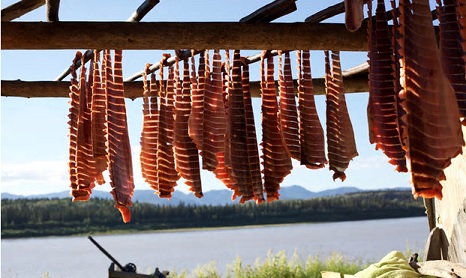
Kings of the wild frontier
In 2013, I sat in a courtroom in Bethel, Alaska, and watched the trial of 23 Yup’ik fishermen, accused of flouting a ban on the fishing of king salmon the previous summer. The ban had been implemented by the Alaska Department of Fish and Game as king salmon numbers plummeted, unexpectedly and inexplicably. The fishermen pleaded not guilty. They were justified in fishing, they said, because the taking of king salmon was part of their spiritual practice, their cultural heritage. First amendment. Mike Williams, then chief of the Yup’ik nation, pulled me to one side during a recess. “Gandhi had his salt, we have our salmon,” he said. For the Yup’ik, getting arrested was no accident. They had issued a press release about their intention to fish before setting out. >click to read< 14:46
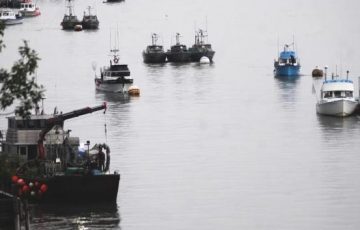
Upper Cook Inlet – Commercial fishermen to open with regular periods
Commercial fisheries managers in Cook Inlet are moving forward with a cautious eye on salmon runs but relatively normal fishing regulations for the summer. An Alaska Department of Fish and Game announcement released Friday detailed the 2018 commercial salmon fishing management strategy for Upper Cook Inlet. Managers are predicting a somewhat lower Kenai River late-run king salmon return, but it’s still within the sustainable escapement goal; the sockeye salmon forecast for the Kenai River is predicted to be 2.5 million, which is about 1.1 million less than the recent 20-year average. >click to read<08:04
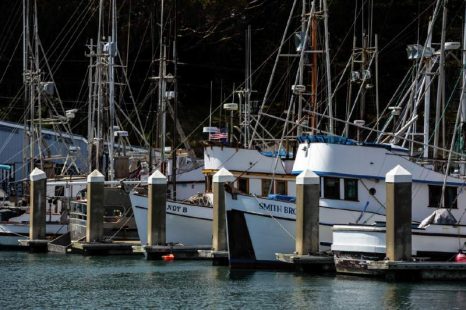
Has California’s salmon fishery hit bottom?
A third straight year of low king salmon runs is expected to deliver another blow to one of the North Coast’s most iconic and lucrative fisheries, wildlife managers indicated Thursday, as both regulators and fishermen faced the prospect of a federally -mandated plan to reverse the trend and rebuild key stocks. The grim news comes amid a dramatic, years-long decline in the state’s commercial salmon landings, which are down 97 percent last year from their most recent peak, in 2013, when they hit 12.7 million pounds. The full picture for commercial and sport seasons won’t be clear for several more weeks,,, >click to read< 13:01
Fisherman’s tagging experiment offers evidence that setnet-caught kings survive
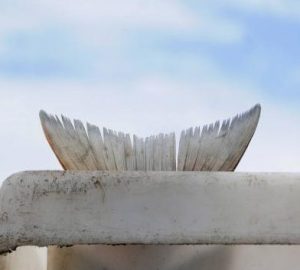 After the disastrous summer of 2012, when poor king salmon returns gave commercial Cook Inlet east side set gillnet fishermen only a handful of fishing days throughout the season, Brent Johnson began brainstorming. A lifelong setnetter in the Clam Gulch area, Johnson knows he is allowed to harvest and sell king salmon under his commercial fishing permits, but he began thinking up ways to winnow out kings from the rest of the salmon. That way, he could release the kings alive and let them head up the river, contributing to escapement goals so the Alaska Department of Fish and Game could leave the setnet open, allowing him to still catch other kinds of salmon. After a few seasons of testing experimental nets and tagging kings he released, he finally has some results to show, indicating that kings may survive being released from setnets. click here to read the story 14:26
After the disastrous summer of 2012, when poor king salmon returns gave commercial Cook Inlet east side set gillnet fishermen only a handful of fishing days throughout the season, Brent Johnson began brainstorming. A lifelong setnetter in the Clam Gulch area, Johnson knows he is allowed to harvest and sell king salmon under his commercial fishing permits, but he began thinking up ways to winnow out kings from the rest of the salmon. That way, he could release the kings alive and let them head up the river, contributing to escapement goals so the Alaska Department of Fish and Game could leave the setnet open, allowing him to still catch other kinds of salmon. After a few seasons of testing experimental nets and tagging kings he released, he finally has some results to show, indicating that kings may survive being released from setnets. click here to read the story 14:26
The PenAir terminal in King Salmon: where the world meets to fish
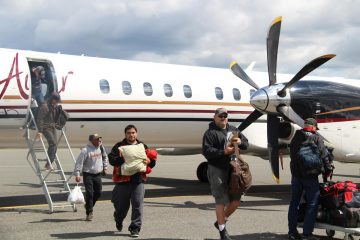 The Bristol Bay Borough swells from a year round population of about 1,000 to closer to 10,000 for the summer fishery. Almost all of the fishermen, seafood processors, and thousands of sport fishing and wildlife viewing visitors on the east side of Bristol Bay pass through one very busy small terminal in King Salmon. In the winter this airport only has two flights per day, but during the peak of the summer it serves up to 14 flights daily. The human traffic into Bristol Bay mirrors the sockeye run, but the people aim to be here a few weeks earlier than the fish. Richberg said the PenAir terminal in King Salmon will see 600 to 800 customers pass through in a day. click here to read the story 12:43
The Bristol Bay Borough swells from a year round population of about 1,000 to closer to 10,000 for the summer fishery. Almost all of the fishermen, seafood processors, and thousands of sport fishing and wildlife viewing visitors on the east side of Bristol Bay pass through one very busy small terminal in King Salmon. In the winter this airport only has two flights per day, but during the peak of the summer it serves up to 14 flights daily. The human traffic into Bristol Bay mirrors the sockeye run, but the people aim to be here a few weeks earlier than the fish. Richberg said the PenAir terminal in King Salmon will see 600 to 800 customers pass through in a day. click here to read the story 12:43
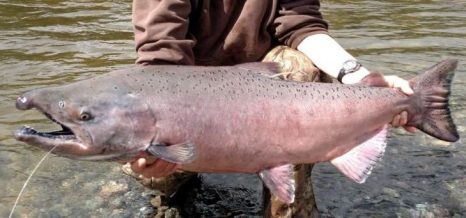
State of the kings
For the first time in years, king salmon are showing signs of making a stronger return to the vast wilderness surrounding Alaska’s urban heartland. While Panhandle runs continue to struggle, kings to the north appear to be coming back in reasonable numbers. No records are being broken, but there are enough fish the Alaska Department of Fish and Game has liberalized fishing in two of the state’s most popular roadside king salmon drainages – the Kenai River south of Anchorage and tributaries to the Copper River east of the state’s largest city. A near disaster had been forecast on the latter river, a big, muddy, glacial stream draining 26,500 square miles of Alaska near the Canadian border. A return of only 29,000 fish was expected, and with the spawning goal set at 24,000, the state imposed a host of restrictions on the fishery before it even began. Sport fishing was closed. Subsistence fishermen were restricted to a seasonal limit of only two Chinook, the more common Lower 48 name for kings. And commercial fishermen faced major reductions in fishing time and closures of areas that have in the past produced the biggest king catches. click here to read the story 09:37
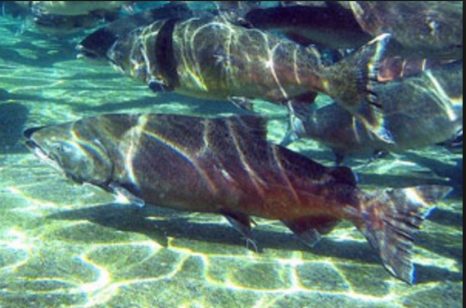
So many kings
With the commercial catch of king salmon off the mouth of the Copper River steadily growing, the Alaska Department of Fish and Game has gone all in on the idea that a preseason forecast that suggested a return of only 29,000 of the big fish was in error. The agency on Friday announced it will lift a restriction that limited subsistence fishermen on the Copper to two fish, and open sport fisheries along the river it had ordered closed before the season even began. The action comes amid mounting public pressure for the agency to see the annual catch of kings, or Chinook as they called elsewhere, is shared among subsistence, commercial, sport and personal-use fishermen. The subsistence fishermen, who are supposed to have a legal priority on harvest, started the season limited to two fish, and told they would get only one-fifth slice of an allowable harvest of only 5,000 kings. That whole plan has now been ditched. click here to read the story 10:37
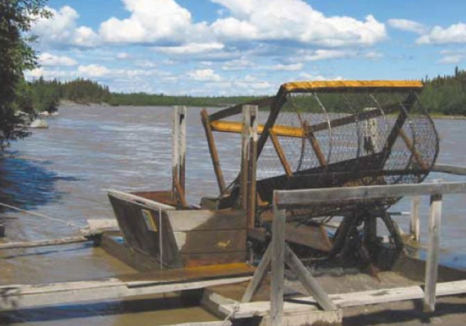
Good bad news?
The Copper River commercial salmon fishery ended Tuesday almost 2,000 Chinook over the 5,000-salmon threshold the Alaska Department of Fish and Game set as the acceptable harvest for 2017, and the fishing season has only begun. Steve Moffitt was at the time reported to be hiking somewhere along the Appalachian Trail on the East Coast of North America some 4,500 miles southeast of the tiny port, community of Cordova on the West Coast not far from the mouth of the Copper. Who the hell is Steve Moffitt? He’s the commercial fisheries biologist who penned a bombshell forecast calling for the return of but 29,000 king salmon, as Alaskans most often call Chinook, to the Copper River this year. He then promptly retired, leaving behind what has now become Alaska’s most watched fishery for a number of reasons: click here to read the story 19:50






